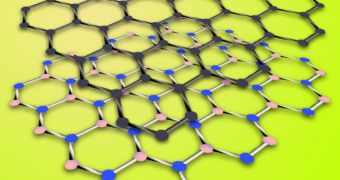Ever since graphene was discovered at the University of Manchester in 2005, experts have known that using it for practical applications would depend on finding a suitable substrate material. A collaboration of researchers in the United States now claims to have developed such a material.
Following a long investigation, the joint team determined that boron nitride substrates are thus far the best alternative available for creating graphene-based materials. The two materials can apparently get along very well with each other.
Details of the research were published in a recent issue of the esteemed scientific journal Nano Letters. The work was carried out by experts at the US Department of Energy’s (DOE) Lawrence Berkeley National Laboratory (Berkeley Lab) and the University of California in Berkeley (UCB).
Berkeley Lab Materials Sciences Division scientists Michael Crommie and Alex Zettl each led a group of scientists. The two, who are also UCB professors of physics, put their teams together for this study.
The main purpose of the work was to determine the best possible substrate for graphene. The material had to meet some very strict requirements, the most important of which was not to destroy graphene's sensitive chemicals and physical properties.
The material discovered at the University of Manchester is a derivative of graphite. It features a hexagonal lattice of carbon atoms, and has only 2 dimensions (2D). The carbon compound is widely believed to be the strongest material ever synthesized.
Physicists and the electronics industry admire the material for its ability to conduct electricity with extremely low resistivity, while at the same time allowing the electron flow to remain highly mobile.
But the problem with it is that these properties are volatile, prone to being destroyed by interactions with substrates. As such, the discovery of the boron nitride mix is therefore very important.
“Any substrate influences the properties of graphene, so if you want to study its intrinsic properties the best way is to work with suspended graphene,” explains University of Hamburg expert Régis Decker.
“However, suspended graphene is quite unstable when investigated with scanning probe techniques like scanning tunneling microscopy, because the graphene membrane can vibrate under the tip,” he adds.
“So the idea is to find a substrate that mimics the case of suspended graphene,” says the expert, who is a former postdoctoral fellow in the Crommie group, and also the lead author of the Nano Letters report.
Using STM, the researchers imaged the interactions between boron nitride and graphene, and determined that the former does not destroy the latter's precious physical properties. This may open the way to practical applications featuring graphene.
“The graphene/BN system is really much nicer than any other substrate for a range of applications,” explains Michael Crommie.
“There are many fewer impurities, much less charge inhomogeneity, much less bumpiness, and much more stability – in all, a much cleaner environment for studying graphene’s intrinsic properties. Boron nitride is a really fabulous system for practical graphene devices,” he concludes.

 14 DAY TRIAL //
14 DAY TRIAL //